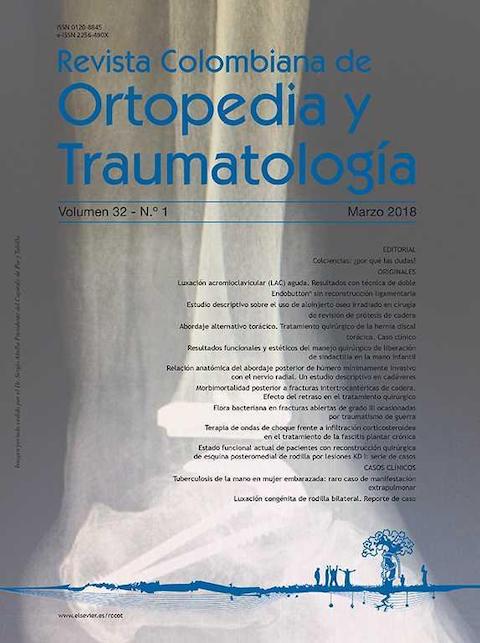Alternative thoracic approach. Surgical treatment of the thoracic disc hernia. Clinical case
DOI:
https://doi.org/10.1016/j.rccot.2017.07.009Keywords:
thoracic approach, thoracic disc herniationAbstract
Background: The aim of this paper is to describe a modification in the posterior approach technique as a viable alternative in the surgical treatment of thoracic disc disease.
Materials and methods: A 29-year-old female patient with a diagnosis of a symptomatic central (T11) thoracic disc herniation. Surgical treatment was performed by discectomy by modified posterior approach.
Results: The outcome was favourable with total reversion of the signs and symptoms presented. There were no perioperative complications, and follow-up at 3 and 6 months was acceptable with clinical, radiographic and tomographic controls.
Discussion: Numerous anterior, posterior and thoracoscopic approaches have described for the treatment of symptomatic thoracic disc disease. There is no precedent published in the literature on the modified posterior route used as an alternative treatment of this pathology. At present, all the techniques described are a valid option for the treatment of symptomatic thoracic disc diseases. Despite being a single case treated with the type of approach employed, the intention is making it a valid alternative for spinal surgeons unfamiliar with the anterior route. There is a lack of prospective studies, with longer follow-up and a larger number of patients in order to validate the surgical technique used.
Evidence level: IV.
Downloads
References
Bilsky MH. Transpedicular approach for thoracic disc herniations. Neurosurg Focus. 2000;9:e3. https://doi.org/10.3171/foc.2000.9.4.4
Black P. Laminotomy/medial facet approach in the excision of thoracic disc herniation. Neurosurg Focus. 2000;9:e6. https://doi.org/10.3171/foc.2000.9.4.6
Kalfas IH. Laminectomy for thoracic spinal canal stenosis. Neurosurg Focus. 2000;9:e2. https://doi.org/10.3171/foc.2000.9.4.3
Kim KD, Babbitz JD, Mimbs J. Imaging-guided costotransversectomy for thoracic disc herniation. Neurosurg Focus. 2000;9:e7. https://doi.org/10.3171/foc.2000.9.4.7
Mc Inerney J, Ball PA. The pathophysiology of thoracic disc disease. Neurosurg Focus. 2000;9:e1. https://doi.org/10.3171/foc.2000.9.4.2
Sasaki S, Kaji K, Shiba K. Upper thoracic disc herniation followed by acutely progressing paraplegia. Spinal Cord. 2005;43:741-5. https://doi.org/10.1038/sj.sc.3101781
Stillerman CB. Introduction to thoracic disc disease. Neurosurg Focus. 2000:9, intro. https://doi.org/10.3171/foc.2000.9.4.1
Vollmer DG, Simmons NE. Transthoracic approaches to thoracic disc herniations. Neurosurg Focus. 2000;9:e8. https://doi.org/10.3171/foc.2000.9.4.8
Downloads
Published
How to Cite
Issue
Section
License
Copyright (c) 2024 Revista Colombiana de ortopedia y traumatología

This work is licensed under a Creative Commons Attribution 3.0 Unported License.




